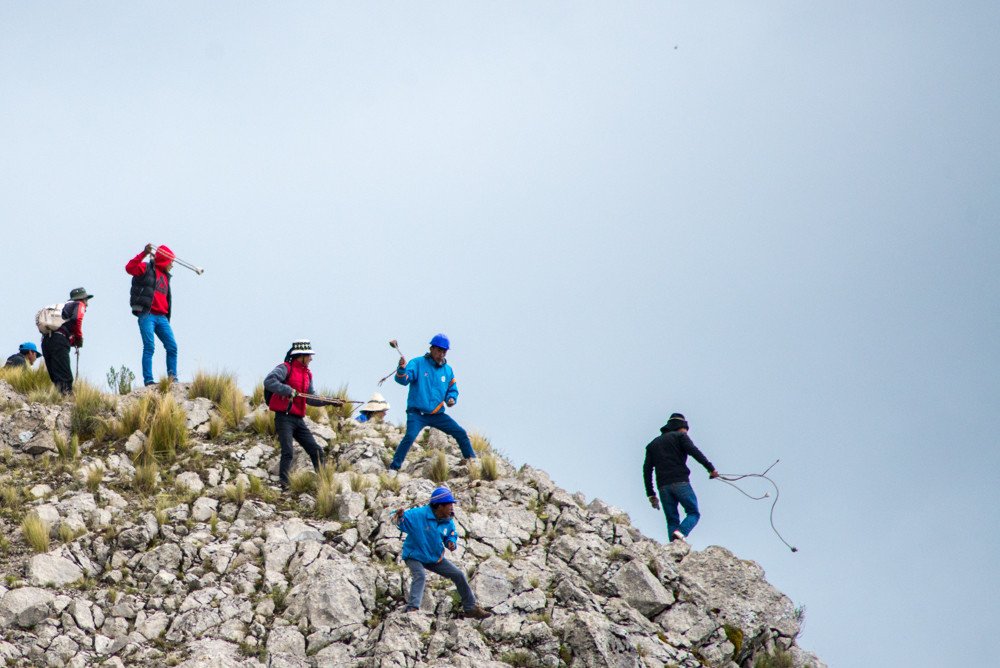The Peruvian Andes have unique and curious traditions, like “chiaraje,” an ancient ritual that combines ceremonies, competition, and combat. Every January 20th, two villages in the Cusco region, in the Canas province, gather to start this fighting ritual.
This distinctive tradition symbolizes fertility, community strength, and ancient Andean customs. Although this practice involves punches, physical hits, and even injuries, it’s more than a battle royale. Keep reading to get into the costumes, traditions, and importance of this ancient practice
Geographical and Historical Context
The term”Chiaraje” has aymara and quechua influence. “Chiayara” means black in the Aymara language, while “aqe”, another term in Quechua is rendered as rock or stone. The Canas province, the place where this practice takes action, has arid land and high-altitude pastures.
Along with its harsh climate, weather also includes cold winters and a short rainy season. Communities in this area depend primarily on agriculture and livestock for survival. This ritual occurs at 4,800 meters above sea level in the desolate “pampa” of Yuraqkanca, a place revered for its sacred significance.
This province is part of the Aymara cultural sphere, it has a history of exchanging land and culture with neighbors, like the Canchis and Collas, so these ritualistic battles predate Inca dominance.
Locals claim that this battle honors Pachamama (Mother Earth). The more people bleed, the better it’ll be for Pachamama, as spilling participants’ blood will ensure prosperity and well-being for the year ahead.
Structure of the Ritual
The battle takes place in two distinct phases, separated by a communal break. Participants are divided into two groups: the “zona alta” (highlands) and “zona baja” (lowlands). These often align with territorial or political divides.
Then, the fighters, wearing traditional customs and armed with slings, stones, whips, and “boleadoras”, fight. Their clashes symbolize both competition and unity. The battle ritual is also divided into two phases, the morning and afternoon phases.
Morning Phase
The first phase begins with an offering to Pachamama and the apus (mountain deities), led by community elders. These rituals involve prayers, coca leaf, and chicha offerings. Around mid-morning, the battle starts without formal signals.
At more than 4,500 meters above sea level scenario, more than one hundred fighters hurl insults to provoke their opponents before using their slings and other weapons. Although fatalities inevitably occur, you can see lots of injured people after the battle. Among the locals, people with some medical knowledge assist the injured.
Afternoon Phase
After a midday break to rest and eat, the second phase resumes with heightened intensity. People get excited thanks to the alcohol, which leads to more dramatic confrontations. The ritual ends with the symbolic “rapto de mujeres” (abduction of women).
This is an act steeped in both traditional courtship and bravado. A woman’s vibrant attire often signals her consent. Many people consider this practice as a pre-marriage ritual instead of an “abduction” itself, and it’s more seen as a comedic action.
Religious and Cultural Significance
The Chiaraje ritual beautifully showcases the Andean worldview that stresses the need for reciprocity, balance, and our link to nature. Blood offerings to Pachamama thanks to the chiaraje battle symbolize the cycle of life and our reliance on nature’s generosity.
This ritual also strengthens community ties that value support over individual success. Pachamama, the earth goddess of the Andes, plays a key role in this ritual, as locals believe that blood and sacrifices please her.
These bring fertility, abundance, and harmony for Canas people. Some researchers describe these rituals as a “dialogue” between humans and the land, in which both success depends on mutual relationships.
Duality and Endurance
The idea behind the division into two groups of participants reflects the Yanantin and Masintin andean duality. This idea shows how two opposite parts can cooperate to coexist and get mutual benefits. That’s why we can affirm this structure it’s not just about geography, but to join forces to keep balance.
Ritual battles like Chiaraje have survived for centuries, even with outside pressures to stop them. During the conquest times, authorities saw these practices as pagan and tried to eliminate them. However, chiaraje adapted and thrived, often blending indigenous beliefs with Catholic elements.
Interpretations and Contemporary Relevance
The Chiaraje ritual has captured the interest of both scholars and the public. The blend of spirituality, community values, and intense moments make Chiaraje a unique event. Many people see this battle as a powerful metaphor for overcoming life’s challenges.
Chiaraje participants think that unity and sacrifice can bring survival and success. Anthropologist Ángela Brachetti says the event’s core is community, not competition. Due to the fierce nature of Chiraje, authorities try to regulate or ban it.
However, due to the distance, the participant’s temperament, and the kind of practice, local authorities feel intimidated and threatened by locals. That’s why, Canas locals still managed to practice Chiaraje even during the Pandemic.
Conclusion
The Battle of Chiaraje stands as a strong symbol of the enduring nature of Andean cultural traditions. This ritual shows the complex bond between humanity and nature, community and individuality, and the past and present.
Chiaraje is a living tradition that offers insights into the Andean worldview, and it also reminds us of the resilience and richness of Peru’s indigenous cultures. Participants passionately advocate for the ritual as a crucial part of their heritage and a way to strengthen their bond with the land.
Peru is filled with this and other traditions just like Chiriaje, to learn more about them, you can stay tuned to our blog! If you want to participate in this tradition, then Peru is waiting for you!
Don’t wait much longer and choose the right option, choose Viagens Machu Picchu. Contact our specialists to start setting up the trip of your life.
Viagens Machu Picchu, journeys that inspire, moments that last.

